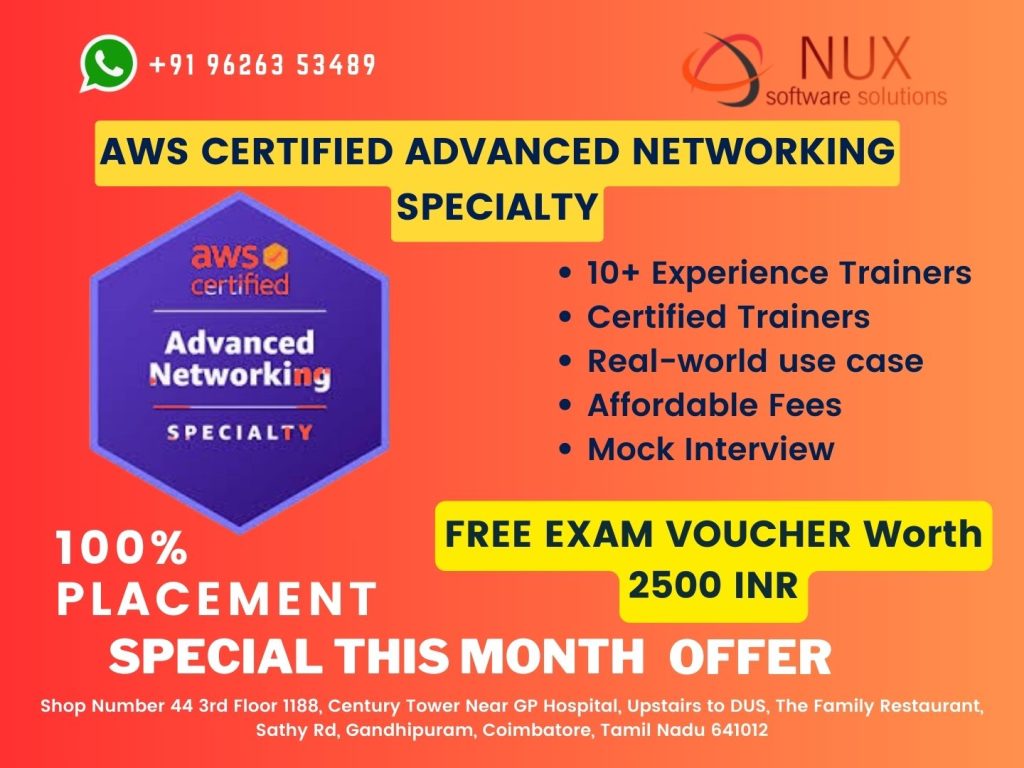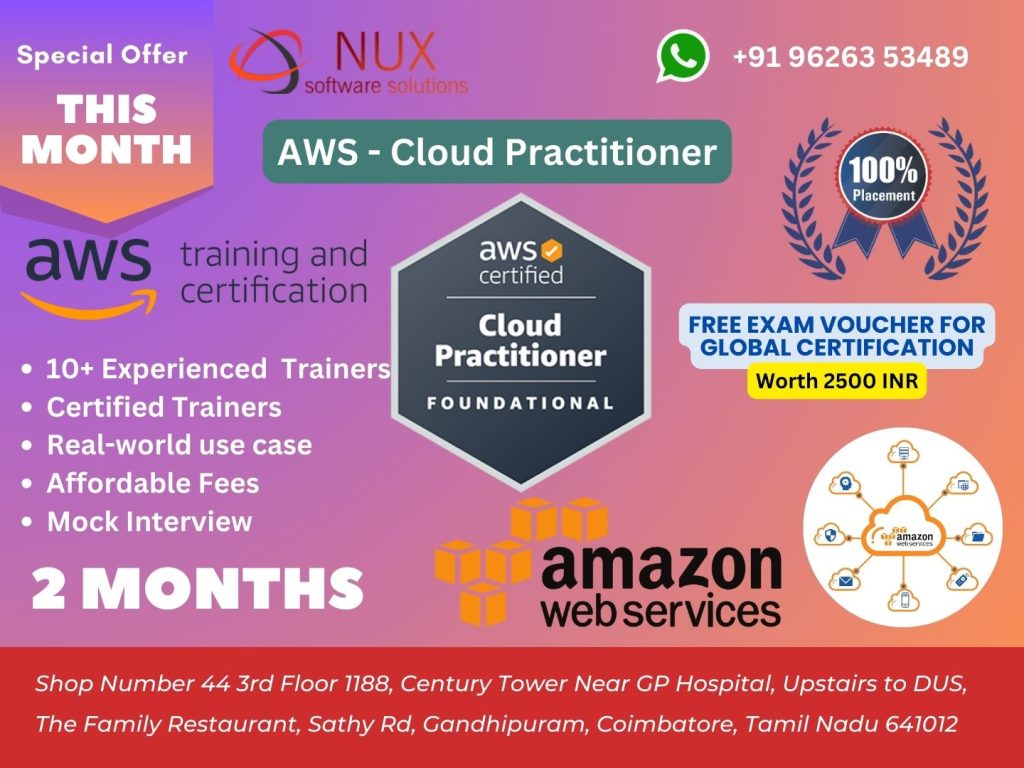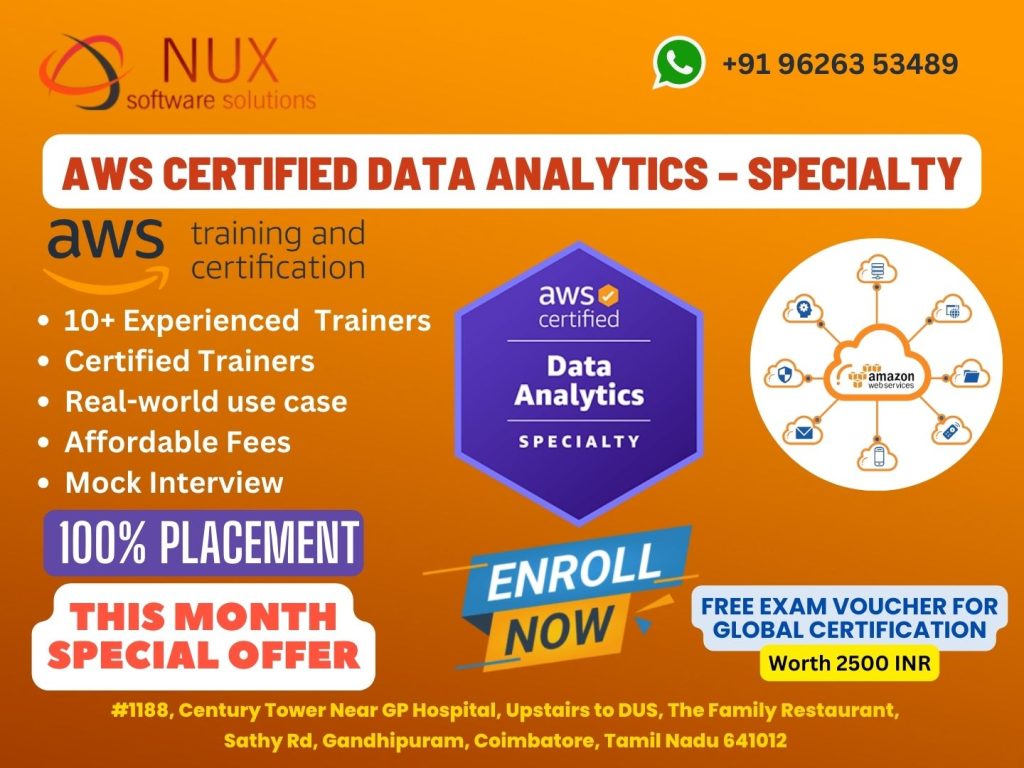AWS certified sysops administrator associate (SOA-C02)

Best AWS certified sysops administrator associate Courses in Coimbatore
Nux Software Solutions Training Institute stands out as a premier provider of cloud computing training in Coimbatore. AWS, a reliable cloud services platform, offers essential compute power, content delivery, database storage, and other functionalities crucial for business growth. Our AWS cloud training is meticulously designed to deepen understanding of AWS architectural principles, empowering learners to navigate and optimize IT architecture through cloud computing innovations.
As a leading AWS training institute in Coimbatore and Tamil Nadu, Nux Software Solutions features experienced professionals with expertise in designing applications and systems on AWS. Our instructors guide aspirants through recommended courses, labs, and exams, ensuring they acquire the technical skills needed for AWS certification
Additionally, our state-of-the-art lab facilities are accessible 24/7, catering to professionals, corporate clients, and individuals seeking live project and industrial training. With a track record of placing graduates in over 500 registered companies and training more than 10,000 students and professionals, we are committed to fostering success in the rapidly evolving field of cloud computing. Join Nux Software Solutions to elevate your career with top-notch AWS cloud training in Coimbatore.
AWS Certified SysOps Administrator - Associate Syllabus
Chapter 1
Monitoring, Logging, and Remediation
Implement metrics, alarms, and filters by using AWS monitoring and logging servicesRemediate issues based on monitoring and availability metrics
Chapter 2
Monitoring & Reporting, CloudWatch Introduction, Monitoring EC2 With Custom Metrics, Monitoring EBS, Monitoring ELB, Monitoring Elasticache, Metrics From Multiple Regions & Custom Dashboards, Create A Billing Alarm, AWS Organizations Lab, AWS Resource Groups & Tagging, Cost Explorer & Cost Allocation Tags, EC2 Pricing Models, AWS Config 101, AWS Config Lab, AWS Config Vs AWS CloudTrail Vs CloudWatch, Health Dashboards, Monitoring & Reporting Summary
Reliability and Business Continuity
Implement scalability and elasticity
Implement high availability and resilient environments
Chapter 3
Deployment & Provisioning, Deploy An EC2 Instance Lab, EC2 Launch Issues, EBS Volumes And IOPS, What Is A Bastion Host?, Elastic Load Balancers, ELB Error Messages, ELB CloudWatch Metrics, Deploying An Application Load Balancer Lab, AWS Systems Manager, Placement Groups, Deployment & Provisioning Summary
Deployment, Provisioning, and Automation
Provision and maintain cloud resources
Chapter 4
High Availability, Elasticity & Scalability 101, RDS And Multi-AZ Failover, RDS & Using Read Replicas, RDS & Using Read Replicas Lab, RDS - Encrypting RDS Snaps, Sharing Encrypted RDS Snapshots With Other AWS Accounts, RDS What Versions, Aurora 101, Aurora Lab, Which Services Have Maintenance Windows, Elasticache, Cloud Front & Cache Hit Ratios, Trouble Shooting Potential Autoscaling Issues, High Availability Summary
Security and Compliance
Implement and manage security and compliance policies
Implement data and infrastructure protection strategies
Chapter 5
Storage & Data Management, Introduction to S3, S3 Lab, S3 Lifecycle Policies, MFA Delete, S3 Encryption, S3 Encryption Lab, EC2 Volume Types, Upgrading EC2 Volume Types - Lab Encryption & Downtime, KMS & CloudHSM, AMIs, Sharing AMIs, Snowball & Snowball Edge, Storage Gateway, Introducing Athena, Athena Lab, Introduction To EFS, EFS Lab, Storage & Data Management Summary
Networking and Content Delivery
Implement networking features and connectivity
Configure domains, DNS services, and content delivery
Chapter 6
Security & Compliance, Compliance On AWS, DDOS, AWS Marketplace Security Products, IAM Custom Policies Lab, Roles & Custom Policies Lab, MFA & Reporting With IAM Lab, Security Token Service, Security & Logging, AWS WAF, AWS Hypervisors, Dedicated Instances Vs Dedicated Hosts, AWS Systems Manager EC2 Run Command, AWS Systems Manager Parameter Store, Pre-signed URLs with S3, S3 - Restrict IP Addresses, AWS Config With S3, Inspector vs Trusted Advisor, AWS Service Limits, Shared Responsibility Model, other Security Aspects, CloudTrail - Turning It On and Validating Logs, CloudTrail - Protecting Your Logs, Security Summary
Chapter 7
Networking, VPC Overview, Build Your Own Custom VPC - Part 1, Build Your Own Custom VPC - Part 2, Creating a NAT Instance, Network ACLs and Security Groups, VPC Endpoints, VPC Flow Logs, VPC Clean Up, VPC CIDR Calculations, VPC Summary, DNS 101, Register a Domain Name Lab, Weighted Routing Policy Lab, Latency Routing Policy Lab, Failover Routing Policy Lab, Geolocation Routing Policy Lab, Multivalue Answer Routing, DNS Exam Tips
Chapter 8
Automation, Introducing CloudFormation, CloudFormation Lab, Introducing ElasticBeanstalk, Elastic Beanstalk Lab, OpsWorks, Automation Summary
Cost and Performance Optimization
Implement cost optimization strategies
Implement performance optimization strategies



